Archive for the ‘do it yourself’ Category
Saturday, October 16th, 2010
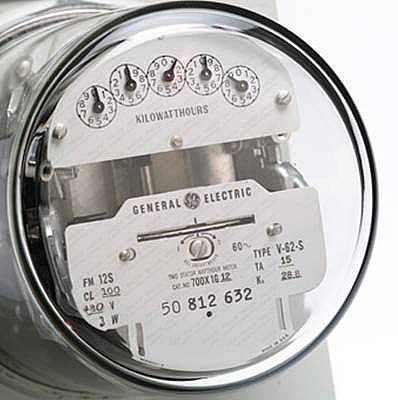
Here is another letter that I recently received that asks some pertinent and common questions related operating a fixer upper house business, that I would like to share with you.
Dear Terry,
We’re moving along towards renting out our first rental house…and I was reading your month-to-month lease agreement from the Never Sell Your Home book– it looks very good and we plan on using much of it, but I did have a few questions:
1) What % of the monthly rent do you require as a security deposit?
2) Should the Lessee(s) be responsible for all utilities, or should I pay the utilities for them?
Thanks for your help – !
Steve Klausman
Santa Fe
Dear Steve,
Congrats on your progress in preparing to rent our your first house. Don’t get discouraged if it’s rough sledding at first, the first house is the one that you learn the most from.
Security Deposit
In answer to your first question, the amount that I charge for security deposit is the amount of one month’s rent. So if the monthly rent is $900, the security deposit is also $900.
Some tenants may have trouble coming up with both the rent and the security deposit at the same time, in this case, a tidy sum of $1,800. So, I sometimes let them pay the security deposit over the course of 2 months, to make it easier on them.
Since you are just starting in the business, something to do from the beginning is to keep the security deposit and the monthly rental money from your business in a separate bank account from your personal bank account. The IRS doesn’t like to see the funds mixed together.
Who Pays Utilities?
In answer to your second question. I always have the tenants pay all the utilities themselves. Not only does it encourage them to conserve, but it vastly simplifies the process for you. Also, I have the tenants put the utility accounts in their own name, so that I’m not liable for their expenses.
In most states, you can sign up for a “Landlord Agreement Account” with the utility companies that allows you to switch the accounts to the tenants and back, with less paperwork and expense.
As you move along feel free to send me more questions as they arise.
Your (self-appointed) personal rental-home consultant,
Terry
Letter on Selecting Tenants
Tags:damage deposit, Terry Sprouse, turn your home into a rental house, who pays utilities
Posted in All Things Real Estate, do it yourself, due diligence, finding tenants, fixer upper houses, how I got started in fixer uppers, how to make money renting housing, How to manage tenants, how to start a real estate business, How to start your own house fix up and rental busines, learn to invest in real estate, tenants, turn your house into a rental | 1 Comment »
Friday, December 5th, 2008
 .
.
I was recently interviewed by the Arizona Daily Star and responded to a variety of questions related to my house fixer-upper business, such as:
Why did you write the book?;
How did you get into the fixer-upper business?;
Can you give away one secret of success?;
as well as several other questions that inquiring minds want to know the answers to.
Here is the complete interview, entitled “UA researcher fixes up houses on the side, writes about it.”
See also:
For yet another newspaper interview that I did see: Fixer Upper Business Highlighted in Newspaper Article.

 Subscribe in a reader
Subscribe in a reader
Share this: del.icio.us | Digg | Ma.gnolia | Reddit | Stumble Upon |
Tags:Fix em Up Rent em Out, fixer upper house business, fixer upper houses, Josh Brodosky, newspaper interview, secret of success, why write a book
Posted in book publishing, book writing, buying fixing renting rehabs, buying real estate, do it yourself, Fix em Up Rent em Out, fixer upper book, fixer upper houses, fixer uppers, fixer-upper business, fixing rental houses, how I got started in fixer uppers, how to make money renting housing, how to start a real estate business, How to start your own house fix up and rental busines, investing in real estate, investmet properties, learn to invest in real estate, newspaper, newspaper articles, real estat investing, real estate books, real estate investing, real estate principles, recession and real estate, rental houses, rental property, success | 2 Comments »
Monday, September 1st, 2008
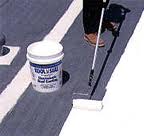 ‘
‘
Investment House Search Update
Despite the debacle last month, my wife and I are back to beating the bushes looking for our next “dream” fixer-upper house. Our plan is to find another one that we can live in while we repair it. That has worked out pretty well on the one we are living in now.
Of course, if a great deal for a regular rental pops up, we’d probably grab that too.
Rains = Leaks
We got some heavy rain Saturday. I received a call from a tenant Saturday night. She reported three leaks in her house. I knew it was time to re-coat the roof last spring, but I thought it would hold out throught one more rainy season. I was wrong.
So, flat roofs being what they are, the roof has to be dry before it can be patched. And, there has to be no threat of rain, or the coating will just wash off again. Been there, done that.
There is a 30% chance of rain today, but for the rest of the week the forecast is 0%. Tomorrow ought to be a good day to take care of it.
Tags:dream fixer upper house, leaky roofs, roof coating, roof repairs
Posted in buy, do it yourself, fence repair, house repair, house repairs, investment house, leaks, learn repair skills, learn to make repairs, making repairs, rain, repair, repairing properties, repairing rental houses, repairs | 1 Comment »
Thursday, August 21st, 2008
Tags:fixer upper house business, home repairs, lean to make repairs, making repairs
Posted in buying fixing renting rehabs, do it yourself, Fix em Up Rent em Out, fix up houses, fixer upper houses, fixer uppers, house repair, house repairs, learn repair skills, learn to make repairs, making repairs, painting, rental property, repair, repair books, repairing properties, repairing rental houses, repairs | 3 Comments »
Monday, July 14th, 2008
Buying fixer upper houses and converting them into rental houses is a great business. And anyone can do it. You don’t need a certificate, you don’t need a degree, and you don’t need anyone’s permission. You just do it!
To view a condensed version of how I got started in the fixer-upper business, check out my article at ezinearticles.com. This is the version with no bells or whistles, and no accompanying three-part harmony.
The townhouse closing may or may not happen today. If not, Angy has to catch a flight out of town tomorrow. In that case, we will have to sign power of attorney over to me so that I can sign for both of us at closing.
Just like the recipe for my famous extra-chewy chocolate chip cookies, the plot thickens!

 Subscribe in a reader
Subscribe in a reader
Share this: del.icio.us | Digg | Ma.gnolia | Reddit | Stumble Upon |
Tags:fixer upper houses, how I got started, investing in fixer uppers
Posted in buying fixing renting rehabs, buying real estate, closing, do it yourself, fix up houses, fixer upper houses, fixer uppers, fixer-upper business, fixing rental houses, house buying, how I got started in fixer uppers, how to start a real estate business, How to start your own house fix up and rental busines, investing financial independence, investing in real estate, investing in your spare time, investment house, investment property, investments, investmet properties, making repairs | No Comments »
Monday, April 7th, 2008
‘
There are very few conversations that include the word “grout” in them. Grout is one of the most under utilized words, and unappreciated substances in the English language. Yet, where would tilers be without grout? And yes, where would all of us who have tiled floors or walls be without this cementy substance?
This weekend, in a never-ending effort to finish repairing our fixer-upper house so we can rent it out, the family undertook to tile the closet floor. This was one of several smaller do-it- yourself projects that remain to be done before we can call this house finished.
Here is how it went down.
Step 1.
Number 1 son expertly cuts tile for the floor (note ear plugs -not an MP3- for protection).

Number 1 son precisely mixes the mortar to the right “peanut buttery” consistency.

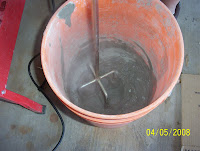
Number 2 son carefully transfers the mortar from the mixing bucket to the transfer bucket.
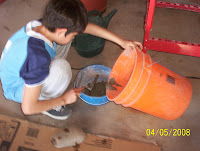
Number 2 son and I precisely apply mortar to back of tile. Number 2 son expresses amazement over incredible precision.

Angy relentlessly spreads the much-anticipated “grout” into the spaces between tiles.


 Subscribe in a reader
Subscribe in a reader
Share this: del.icio.us | Digg | Ma.gnolia | Reddit | Stumble Upon |
Tags:do it yourself, preparing grout, repairing fixer upper houses, repairing rental houses, using grout on tiling project
Posted in do it yourself, grout, mortar, rental house improvements, repair, repairing properties, repairing rental houses, repairs, tile, tile cutting | 2 Comments »
Sunday, November 18th, 2007
Sunday, work continued on the fixer-upper house that we live in, and plan to sell (for more info on this investing strategy, see “How to Turn Your Home into a Rental Property, Instead of Selling It!” coming in Sept. 2012.) There was a little grouting left to do in one of the
bathrooms, around the tiles that made a baseboard-type border abound the bathroom floor.
Here are the tools I used – small bucket, white grout, a trowel, and a small “mud” (or joint compound) spatula (not pictured)

I mixed up a small amount of grout. Add water to the powder until you have grout the consistency of peanut butter.
When I mix grout, I wear a mask or kerchief to cover my mouth and nose. The grout mix contains cement, so if you breath in the powder it can scar your lungs.

I apply the grout with the small spatula.
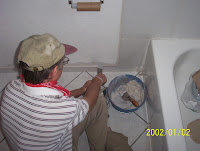
Afterwards, I clean up tools with water.
After the grout has cured for three days, I apply grout sealer.
There are two pretty good books on floors and tiling published by Home Depot, “Tiling 1-2-3” and “Flooring 1-2-3“. I recommend “Flooring 1-2-3”, if you just want to buy one book. It cover tiles about as well as the other book, and also addresses how toinstall several other types of flooring. I used it as a guide to install both laminate flooring, and vinyl flooring.
As always, to make money in the fixer-upper business its best to do everything yourself. You learn by doing. Start small but work up to bigger projects.
Our first tiling project was in a small bathroom, a good place to learn the process. But since then, my wife and I have worked our way up to doing large bedrooms. We feel comfortable tackling any tiling project now.

 Subscribe in a reader
Subscribe in a reader
Share this: del.icio.us | Digg | Ma.gnolia | Reddit | Stumble Upon |
Tags:books on tiling and flooring, do it yourself, fixer upper house business, grouting project in bathroom, Home Deport books, start, turn your home into a rental property
Posted in do it yourself, fixer upper houses, fixer uppers, fixer-upper business, fixing rental houses, grout, house repair, house repairs, how to turn your home into a rental property, making repairs, rental house improvements, rental houses, rental properties, rental property, rentals, repair, repair books, repairing properties, repairing rental houses, repairs, small investor, start small, Uncategorized | 2 Comments »
Friday, November 16th, 2007
 In the fixer upper rental house business, we must constantly monitor the status of our property.
In the fixer upper rental house business, we must constantly monitor the status of our property.
I was reminded of this again when we discovered that we had termites in one of our bedrooms. This is a fixer upper house that we are living in as we make repairs; soon to be a rental house. My son bumped his foot against the floor trim and found that there was no longer any wood trim there. All that was left was the the shell of the paint in the form of the trim. The wood had been completely eaten by termites.
Hiring a Pest Control Professional
I usually like to do all fix-up type repairs myself, but this is a case where I let the exterminators (no relation to the California governor) do the work. The first few companies I called would not give me a quote over the phone. The one company that gave me a “rough estimate” came in at a budget busting $1500 to $2,000 for a 1600 sq.ft. house. The job must be based on the square footage of the house, so it’s not rocket science to calculate the cost. It makes it impossible to compare companies if they all have to come to the house before they can give me an estimate! They think that after you invest the time to have them come over, you’ll just fall for their sales pitch, rather than spend any more time finding the best deal (and at the same time you’re concerned that your house is crumbling from the relentless termite onslaught).
So, I kept calling. After several more calls I connected with A-OK Termite and Pest Control and they really were “A-OK” because they gave me a bid of $650 without a house business. They did the job last Saturday.
Termite Living Habits

Yikes! Termites
Here in the desert southwest, we have subterranean termites, which I believe are the singlemost common type. They live in colonies deep within the ground, sometimes to depths of 25 feet. Termites work their way up through the soil from their nest and enter any wood they can. Termites can gain entrance by crawling up the sides of foundations, building mud shelter tubes to shield them from light, or they can go up hollow sections in block foundations or up cracks in the poured concrete foundations.
Every 48 hours or so termites must return to the soil to get moisture or they will die. The exterminator (again, no connection to Arnold) sets up a barrier of chemicals in the soil that the termites cannot pass through. They usually inject chlordane into the the soil every eighteen inches around the entire house. The same procedure can be done inside the house.
Even if only one part of the house is infested, the entire house must be termite-proofed or the termites will migrate to the untreated parts.
The time it takes termites to do serious damage varies from only a couple of years to 10 or more years. So, if you think you might have termites, don’t put off taking care of them too long. If it’s been 5 years since the last treatment it’s time to have the house inspected.

 Subscribe in a reader
Subscribe in a reader
Share this: del.icio.us | Digg | Ma.gnolia | Reddit | Stumble Upon |
Tags:dealing with termites, fixer upper rental house, hiring contractors, live in fixer upper house while making repairs, making repairs, termites in rental houses
Posted in contractor calculations, contractors, do it yourself, fix up houses, fixer upper houses, fixer uppers, fixer-upper business, fixing rental houses, investment property, learn to make repairs, live in, making repairs, managing tenants, property damage, repairing properties, repairing rental houses, repairs, Uncategorized | No Comments »
Monday, October 29th, 2007

Want to teach your kids how to manage money? Do you want them to share your desire to develop income independence?
In the post “Do As I Do” at Overcoming Real Estate Obstacles, Carol says, “You’ll never be financially secure working for someone else. Your job, as much as you love it, is always at risk for many different reasons. Therefore, you need to make your job a bit less important. The only way to do this is to start a business of your own. You can begin small, while you’re still working. That way, you will be prepared if your fired, laid off, or the company you work for shuts down.”
And she says that the way that our kids learn about financial realities is by setting a good example. If they watch us do it, they are far ahead of the pack. I encourage you to read this excellent article.

 Subscribe in a reader
Subscribe in a reader
Share this: del.icio.us | Digg | Ma.gnolia | Reddit | Stumble Upon |
Tags:begin small, do as I do, Overcoming real estate obstacles, refinancing a house, start a business of your own, you'll never be financially secure working for someone else
Posted in do it yourself, investing, investing financial independence, investing in real estate, investing in your spare time, investment house, investment property, investments, investmet properties, money, multiple careers, real estate investing, real estate principles, success, teaching children | No Comments »
Tuesday, October 23rd, 2007
Sunday was a day to continue work on our present fixer upper house.
The house had a leaky cooler on the roof when we bought it. I repaired the roof with E-LAS-TEK rubberized roof coating (for flat roofs like we have in Tucson), but I had not repaired the ceiling until Sunday It had been stained by the water from the roof.
(The picture dates are wrong. I didn’t update the camera last time I changed batteries.)

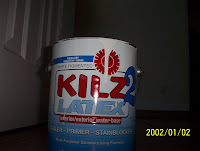
I scraped the old paint away above the bathtub. I used joint compound (“mud”) to patch the spot. After the mud dried, I brushed on “Kilz” to cover the stains and to prevent any future leaks from the roof to stain the ceiling. Later, I will paint it again with the white latex paint we are using for the bathroom.

Another project I worked on Saturday was to continue painting the house roof overhang. It could easily have been 50 years since some sections of the overhang were painted, other sections never had paint. The wood absorbs the paint like a sponge. The wood is so old that, in places, a it has a hair-like covering. Before painting, I scape off the hair (I give it a shave) with one of my “mud” spatulas. You could probably use a wire brush too, but it comes off pretty easy with the spatula.
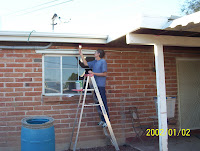
I started off using the cheap $1.00 “throw-away” brushes that you can buy at Home Depot. They didn’t hold the paint too well, so now I am using a more expensive brush which is working a little better. The paint spreads a little easier.
Most people wouldn’t notice whether or not the overhang was painted. However, we want this house to last a long time, so the paint goes on.
As I mentioned in an earlier blog, my wife & I do the repairs on this house in fits and starts. Since we live in the house, we don’t have the the pressures to do it rapidly, like we did for our last fixer-upper house. (For more info, see my latest book “How to Turn Your Home into a Rental House, Instead of Selling It).
For that one, the “Planeta” house, we worked late into the evenings and we would take turns getting up early the next morning, to put a few hours in before going to work. One of us would stay home with the sleeping kids. Making the monthly mortgage payments and all the repair costs that we were racking up, gave us real motivation to finish and get a renter in there ASAP.
In the present situation, it works best for me when I set easy short-range goals. Right now my goal is simply to get up early & paint for one hour before I eat breakfast and get ready for work. On weekends I can do more, but just an hour a day keeps the ball rolling.

 Subscribe in a reader
Subscribe in a reader
Share this: del.icio.us | Digg | Ma.gnolia | Reddit | Stumble Upon |
Tags:ceiling repair for fixer upper, cheap paint brushes, do it yourself, e-las-tek, kilz, living in fixer upper house, painting, throw away paint brushes, turn your home into a rental house, turn your home into a rental property
Posted in do it yourself, fix up houses, fixer upper houses, fixer uppers, fixing rental houses, house repair, house repairs, how to turn your home into a rental property, learn repair skills, learn to make repairs, making repairs, painting, repairing properties, repairing rental houses, repairs, turning my home into rental property, turning your home into a rental property | No Comments »










